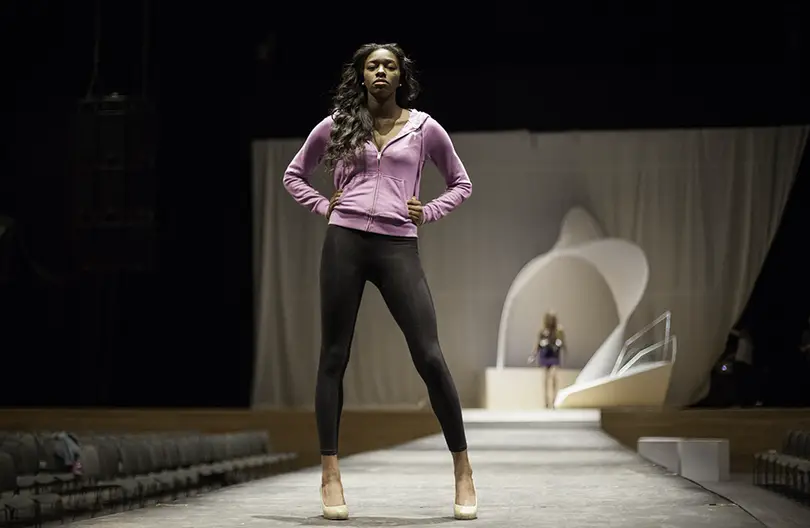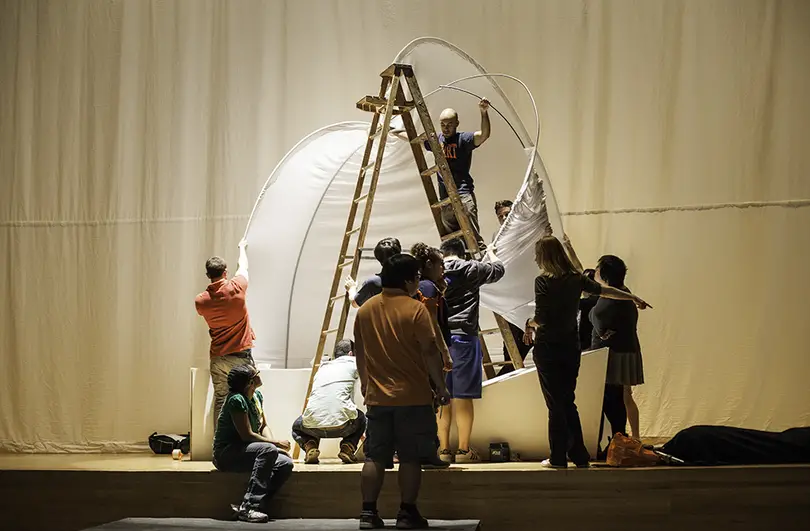Project runway: Students create, plan designs for Senior Collection fashion show
After long, hectic days and even longer nights at the Warehouse, Syracuse University’s Senior Collection fashion designs are ready to be paraded down the runway and on display for all to see.
Senior fashion design majors in the College of Visual and Performing Arts will show off their collections to audiences in the Schine Student Center on Thursday night. There will be two shows: the matinee at 12:30 p.m., and the 7:30 p.m. show. The collections have been in the works for at least three weeks.
“We make the show. The only thing we’re given is the venue,” said Sandina Saint Elien, a senior designer and fashion design major. “We are in charge of every single aspect, from the posters to whether or not there are tables on the floor of the auditorium.”
Each designer was given complete creative freedom when designing his or her collection. They were given the opportunity to do their own research and mix together any ideas they felt inspired by. Alix Sadowski, a senior designer and fashion design major, said students were amazed by how different each collection is and how everyone’s ideas transformed into garments.
“My collection was inspired by an art installation called ‘Baitogogo’ by Henrique Oliveira, and it pretty much is a large sculpture of grid beams that morph into these overpowering wooden knots. It’s definitely a juxtaposition of architectural and organic shapes,” Sadowski said.
A designer can spend weeks trying to figure out just how to bring a two-dimensional flat drawing to life. There is also the added factor that what may look perfect on paper does not translate well on a human figure, which makes for a lot of added work.
“We’ve learned that being a designer also means being a problem solver and knowing when to edit,” Saint Elien said.
Not only did the students work hard on creating their own collections, but many also collaborated to find models for the show. The group’s responsibility was to recruit models on campus and in the Greater Syracuse area and manage them. Students constantly coordinated with models’ schedules, making sure they knew when to attend fittings and whose clothes they would wear.
Students were also in charge of contacting local businesses to sponsor an art book that the class developed. The book, different from the show’s generic brochure in previous years, features portraits and blurbs about the outfits, and showcases each designer’s work.
This year’s class compiled information and biographies of all of the senior designers, setting up a whole weekend of photo shoots to preview the final collections.
“The outcome of this collaboration has been extremely successful and current seniors hope that future classes will want to pursue this project in the years to come,” Sadowski said.
Planning the show is a huge undertaking, Saint Elien said. It’s hard to understand all of the details that go into planning a show at a first glance. From model castings to set design to collaborations with other companies, there are many factors that go into making a successful show.
“It takes a countless amount of work to handle catering, meeting with sponsors, deciding on seating arrangements, managing model lineups and how designers choose fairly among a pool of over 80 models,” Saint Elien said.
The technicalities of the show don’t stop there — it is each individual designer’s job to create a collection of 25 pieces based on a single concept. Designers spent up to three weeks drawing hundreds of fashion figures and different iterations of those sketches in order to decide upon a well-designed group of 25.
From those 25, eight looks are chosen for the fashion show. Each garment goes through three stages: muslin, drape and sample. There are changes and fittings throughout each of the stages, to ensure that the final product is perfect.
Each set design for this year’s show was also made with great consideration in collaboration with the Syracuse University School of Architecture.
“We are very excited this year because we have collaborated with the architecture program to use an installation they have created as the backdrop for the show that the models walk through,” said Nguyen Long Nam To, an assistant professor in the department of design in VPA.
Although the seniors strive to present an effortless transition of models wearing their masterpieces, the backstage is nothing glamorous. Behind the stage there are crowds of designers working to keep their garments in order and roughly 80 models trying to get changed and onto the runway on time.
Said Long Nam To: “While the audience is watching from their seats, many different things are happening backstage. Everything must change — shoes, jewelry, clothing — so it must be an extremely organized and smooth process.”
Published on April 23, 2014 at 3:00 am
Contact Zoe: [email protected]







